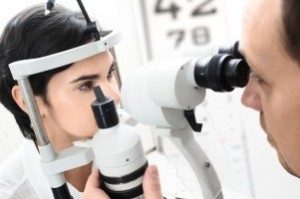Top Eye Health Risks for Women
April is Women’s Eye Health and Safety Month. Did you know that more women than men suffer from visual impairments? Find out which eye diseases pose the highest risk and what you can do to lower your risk
According to the National Eye Institute, 3.6 million Americans age 40 and older suffer from visual impairment, with women accounting for 2.3 million of those cases. The World Health Organization estimates that women comprise more than 64.5% of all visually impaired people worldwide.
Top Eye-related Health Risks Faced by Women
While women face many eye-related health risks, the following are the most common and concerning:
- Cataracts. A cataract is a clouding of the lens of the eye that can impair vision. Cataracts affect nearly 22 million Americans age 40 and older. By age 80, more than half of all Americans have cataracts.
- Glaucoma. Glaucoma is a complicated disease in which damage to the optic nerve leads to progressive, irreversible vision loss. It is the second leading cause of blindness and affects almost 2.3 million Americans age 40 and older.
- Age-related Macular Degeneration (AMD). AMD is a common eye condition and the leading cause of vision loss among people age 50 and older. AMD causes damage to the macula, a small spot near the center of the retina and the part of the eye needed for sharp, central vision, which lets us see objects that are straight ahead. Research shows that 2 million Americans age 50 and older have advanced AMD.
- Dry Eye Syndrome. With this condition, the eyes do not produce enough tears or the tears are poor quality and evaporate quickly. When this happens, the eyes sting or burn, feel scratchy, become irritated or tear excessively. Dry eye affects an estimated 3.2 million American women.
Why Are Women at Higher Risk Than Men?
There are many factors and differences between men and women which put women at greater risk of eye-related health issues. Some of these factors are intrinsically more common in women and some are due to predisposition to disease and lifestyle choices.
- Women live longer. Plain and simple, women statistically live longer than men. Therefore, they are more likely to develop age-related eye diseases such as AMD and Glaucoma (which cause irreversible vision loss) and Cataracts (which require surgery to reverse damage).
- Hormones, hormones, hormones. Pregnancy, birth control pills, hormone replacement therapy (HRT) and menopause all affect a woman’s overall eye health. Pregnancy can cause high blood pressure, dry eye syndrome, eye migraines, light sensitivity and can worsen diabetic retinopathy. Hormones from birth control pills or HRT can come with vascular side effects, which indirectly cause vision problems or loss. Additionally, about 61 percent of perimenopausal and menopausal women suffer from dry, itchy eyes due to hormonal changes.
- Diabetes. One in 10 American women over the age of 20 have diabetes. Diabetes increases the risk of several eye diseases, diabetic retinopathy as well as susceptibility to damage from UV light. Women are also at risk of developing gestational diabetes during pregnancy.
- Smoking. Smoking significantly increases the risk of AMD and cataracts. Researchers have long known that diabetes patients who smoke have higher blood sugar levels, making their disease more difficult to control and putting them at greater danger of developing complications such as blindness. Some science suggests that women may have a more difficult time quitting smoking since smoking is often used as an appetite suppressant.
- Medications. Women take more prescription and non-prescription drugs than men. Many of these drugs can have serious side effects on the eyes.
- Lifestyle choices. Obesity, unhealthy diet and lack of exercise are all contributing factors that can affect overall eye health. Over 60 percent of U.S. adult women are overweight and just over one-third of overweight adult women are obese.
Tips for Taking Care of Your Eyes
The top eye-related health risks in women are mostly due to age, but there are certainly steps you can take to help reduce your risk of these serious eye conditions.
- See an eye doctor. The current recommendation is that everyone should have a comprehensive eye exam by age 40. If you do not have any eye doctor, call us to schedule an appointment.
- Schedule a physical examination with your primary care physician. Not only are women at greater risk for many eye diseases, they are also at risk for several other diseases and health conditions that can impact their vision. Ask your doctor to discuss any risk factors you may be facing.
- Eat a healthy diet and exercise. If you want healthy eyes, you should eat a diet rich in Vitamins C, E, beta carotene, lutein, zinc and omega-fatty acids. These micronutrients help to prevent vision loss from eye disease. This is especially important during pregnancy. Regular exercise reduces your risk of diabetes and obesity.
- Don’t smoke. Smoking significantly increases the risk of AMD (age-related macular degeneration). In fact, smoking doubles the risk. Smoking also increases the likelihood of cataracts. Do you enjoy reading and seeing people’s faces? If so, stop smoking today!
- Wear sunglasses. All women should wear sunglasses with 100% UV protection (and a hat) whenever they’re in the sun. This is essential to protect the eyes from the sun’s UV radiation, which can damage eye tissues. If you take birth control pills, you need to be even more cautious. Plus, sunglasses make you look cool.

